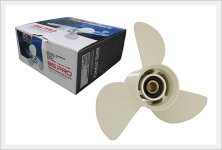This is taken from the Boatfix.com Prop site:
Ventilation occurs when surface air or exhaust gases are drawn into the propeller blades. The load on the propeller is reduced by the mixing of air or exhaust into the water steam causing over revving.
Cavitation: The aeration (bubbling) and boiling effect of water caused by creation of a low pressure area. Generally caused by a solid shape (propeller blade) passing through the water, in such a position and speed, that a low pressure area is formed due to the inability to move through the water in nonresistant manner. An example is, a propeller blade that has a rough edge would not cut efficiently through the water, thus creating a low pressure area. If the pressure drops below the vapor pressure, a cavitation bubble will form in that region. These bubbles will collapse when they reach the higher pressure region of the blade. This causes a rapid change in pressure and can result in physical erosion. You may notice burns (erosion) at some area on the face of the blade.
Is there actual burning of the surface of the prop--rough edges etc? If not there is ventilation. This can be the engine too high for that prop, a depth sounder or other hull appendage causing disruption of water flow.
You may need to drop the engine down one hole--but that may increase the drag slightly--and I wonder if it will be the best plan. Also the configuration of the prop--cup and rake, which are not usually measured can increase turbulence around the prop. First check the edges of the prop, and be sure it is spinning true. I don't think it is the hub.

